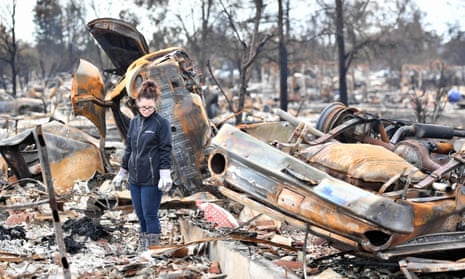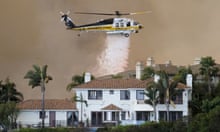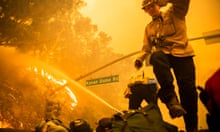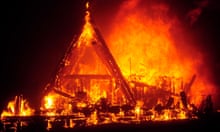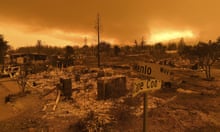Last week, Jeff Sugarman escaped his burning home in Santa Rosa, California. This week he faced the horrors of the region’s housing market.
One of the first inquiries Sugarman made was about a rental house nearby that was listed for $3,700 a month on Zillow. But when he emailed about seeing it, the owner told him the price had soared.
“He said insurance companies had been calling him all day and they were willing to pay $4,700 to $5,000 (to house fire victims) so I’d better be prepared to pay more,” Sugarman said, adding that he told the landlord he was “appalled” and “this was wrong”.
Sugarman passed the communications to the local newspaper and the US justice department, which he said was investigating price gouging in the wake of the northern California fires that killed at least 42 people and destroyed 8,400 buildings.
A spokesman for the California state attorney general’s office said investigators planned to enforce a price gouging provision in the state penal code that prohibits anyone from raising prices more than 10% following the declaration of a state of emergency.
But an analysis, conducted for the Guardian by Zillow, of new rental listings since the fire appeared to show that prices last week compared to the previous month have risen more than is typical for rentals in Sonoma and Napa, the two counties hit hardest by the fires. Between September and last week, Zillow data showed a typical asking rent jumped 36% in Sonoma to $3,224 from $2,366, and 23% in Napa to $3,094 from $2,509. Usually, price increases are down in Napa in October and neutral in Sonoma.

In Sonoma County, where median rents increased by nearly 44% between 2011 and August 2017, according to Zillow, the housing market is already overheated. But last week’s rental prices per sq ft were still on pace to jump 16 times faster for Sonoma and 22 times faster for Napa in October compared to the average monthly rates in June, July and August.
“These data would suggest that rents have increased sharply in Napa and Sonoma counties [since the fires started],” said Aaron Terrazas, a senior economist for Zillow. He cautioned, though, that the analysis was based on the small number of units listed in a single week – 26 new listings in Napa and 30 in Sonoma mostly in single family homes. He said the magnitude of the trends could change as more data became available.
Noting that Santa Rosa had declared a state of emergency about a year ago over the housing shortage and the homelessness crisis, councilwoman Julie Combs said: “Now we’ve lost 5% of our housing and 15,000 people have lost their homes.”
Sonoma County supervisor Susan Gorin, wearing a respirator and boots as she sifted through the ash of her destroyed home last week, said it was her lower-income neighbors who were most likely to be displaced from the area.
“We are so successful as a tourism destination,” Gorin said. “We produce a lot of lower-income jobs – in wineries, in restaurants, in hotels. It’s going to hurt our economy if we don’t get temporary housing for the people who lost their homes in the fire, as well as those who were already on the edge of losing their homes and the homeless.”
Adrienne Lauby, who runs Homeless Action, an advocacy group in Santa Rosa, said there were at least 3,000 homeless people in the area before the fires and the numbers were going up.
“People are already becoming homeless,” Lauby said, adding that she knew of several people who had been kicked out of informal housing arrangements so that the people they were staying with could take in family members displaced by the fire. “There are pop-up encampments all over the city. People are sleeping in the parks, they’re staying in their cars – there are still 425 people in the shelters.”
“All of these people,” she said, “are at risk for homelessness and the winter is coming.”
Gorin said the board should look at options such as trailers from the Federal Emergency Management Agency (Fema), recreational vehicles and cargo containers converted into homes.
Lucien Bisaccio said he and about 30 other people fled from a homeless encampment in the brush below the now-destroyed Fountaingrove neighborhood, after one of the campers woke up to see the whole sky in flame.
“When the sun comes up in the north, you know it’s time to evacuate,” he said.
He said the campers lost everything. He didn’t know where they would go next.
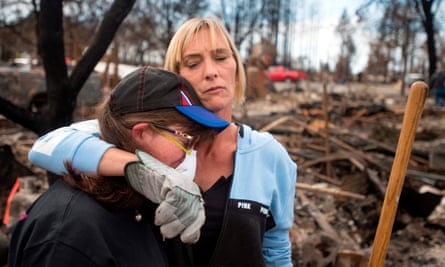
Omar Medina, of the North Bay Organizing Project, has been struggling to line up help for the many undocumented immigrants who work in the region. He said that under federal law families with children who are US residents may qualify for Fema help even if the parents are undocumented. But many workers are afraid to apply because a clause in the Fema paperwork says the information may be passed over to Immigration and Customs Enforcement. Instead some are leaving town.
“We’re seeing people already moving out of the community,” he said, adding that, on Thursday, 170 workers showed up at an event organized by the Mexican consulate in Santa Rosa to aid Mexican citizens affected by the fires. “My biggest fear for my community is losing our diversity.”
Even without price rises, he said, people on the lower end of the income spectrum are likely to be pushed out of the competition for housing by those with more resources for housing deposits and more stable incomes.
His organization has started the Undocufund, which has raised $200,000 to help undocumented workers with money for things like deposits on rentals and emergencies caused by lost wages.
“Our hope is that this disaster will be a wakeup call,” he said. “It’s time now to either step up and provide more housing or we’re screwed.”
This article was amended on 4 December 2017 to remove personal information.
- Do you have an experience of homelessness to share with the Guardian? Get in touch
